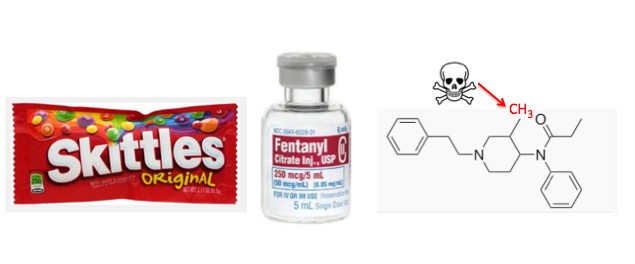 In 1985, a scientist in Delaware decided to make drugs with the goal of getting rich.
In 1985, a scientist in Delaware decided to make drugs with the goal of getting rich.
We didn't know it at the time but DuPont organic chemist Michael Hovey had ushered in the modern era of so-called "designer drugs" by cooking up a batch of 3-methylfentanyl in his lab. The batch had a street value of $112 million.
His choice was not arbitrary. It would be hard to pick a drug that gives you a better bang for your buck than 3-Methylfentanyl which, as you can tell by the name, is closely related to fentanyl, a synthetic heroin that is a legal but highly regulated narcotic 50 times more potent than heroin.
Fentanyl is used as a pain patch (Duragesic), an under the tongue (sublingual) lozenge, and as part of a general anaesthesia cocktail. It is also the drug that is causing the surge of overdoses in heroin addicts, because the lethal dose in humans is estimated to be 2 milligrams— about the same weight as 5 grains of salt. It does not take much imagination to picture a scenario in which some stoned out mutant who is putting together a bag of heroin mixes in an extra milligram or two and kills people.
But, fentanyl is a bag of Skittles compared to 3-methylfentanyl (3MF), which is 100-times stronger. Yikes.

3-Methylfentanyl: The seemingly trivial addition of a methyl group (red) is anything but.
Where did "Breaking Bad" inspiration Michael Hovey go wrong? It wasn't in the synthesis, that was not at all difficult for any trained organic chemist. His error was that he didn't actually know any drug dealers, so he offered a reward to chemists who could find him one. Fellow DuPont chemists instead alerted security and he was arrested when he tried to sell it to what turned out to be an undercover FBI agent. Four years later, after serving an 18-month federal prison term, he committed "suicide by police" by lunging with a knife at Delaware State troopers who came to arrest him for skipping his state trial on similar charges.
Back to the drugs.
To give you an idea of how powerful 3-methylfentanyl is, let's play a guessing game: How much did 3MF did Hovey have to make to end up with $112 million worth of the stuff? A wheel barrel full? A thimble full?
While you are guessing, I will do some math, and you can ridicule me in the comments sections if I am wrong, which is all but certain.
Let's assume that an addict's dose of fentanyl is half (they are addicts, after all) of the lethal dose—1 milligram. Given that, an "effective" dose of 3MF would be 0.01 milligrams (ten micrograms). Assuming a street price of $5 per bag—about what "heroin" costs now—this means that Hovey would have had to make a whopping 8 ounces of it—the same weight as two lemons. Yep, by using four common chemicals that can easily be purchased from any number of chemical research supply companies for a few hundred dollars, Hovey made a drug so potent that $112 million dollars worth of the stuff could fit in his pocket.
When life gives you lemons, try to get rich and then do something really stupid.

Stories from his acquaintances say that Hovey had begun to believe that the world was going to end. He told prosecutors that he wanted a large fortune, which he would then to convert to gold, so that he could ride out the coming cataclysm in the Rocky Mountains, and then return when the apocalyptic dust settled. He was partly right, though his was the only world that would be ending soon.
Ironically, Hovey had already made something better to take to the mountains than gold. A gold brick weighs 12.4 kilograms, or 437 ounces. At the end of 1985, gold sold at $323 per ounce, so a brick was valued at a bit over $141,000. His two lemons worth of 3MF could have fetched 794 bricks (1,750 pounds) of gold. That's an awful lot of weight to carry around.
Addendum: I mentioned Walter White because of the popularity of "Breaking Bad," but White was a rank amateur compared to Hovey. One gram of crystal meth costs about $100 on the street. The same weight of 3-MF? Over $500,000.
Extra credit!!! Answer this question and you will win our new, doubly awesome ACSH coffee mug. First correct answer posted in comments sections gets the prize.
Question: WHY WAS WALTER'S METH BLUE? (No internet cheaters, please. I will know!)
Update, 3/10- We have a winner. Congrats to Kailey. Your answer was almost perfect. Here's the rest:
It was a trick question. Sort of. Walter's meth should not have been blue. The show's chemistry was very accurate (mostly), but this "error" was intentional. It was a plot element. The show implied that the blue color was a function of the purity of the meth because they needed a way to distinguish Walter's meth from the rest, when in fact, if anything, any color would signify that it was less pure, not more. And even if there was a colored impurity, the chances that it would be blue are very small. Impure organic compounds are usually tan, yellow, or brown.
Walter did not add the color, but Vince Gilligan, who wrote and produced the show surely did. If you have seen the show, Gilligan's regular use of color made the already-extraordinary camera work even more stunning.
Kailey, if you email me at bloomj@acsh.org, I will personally deliver your mug to the post office. Thanks to all of you who played. Let's do it again some time.




